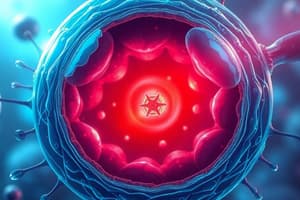Podcast
Questions and Answers
The cell membrane is a single layer of phospholipid molecules.
The cell membrane is a single layer of phospholipid molecules.
False (B)
Organelles are distinct structures within the cytoplasm that perform specific functions.
Organelles are distinct structures within the cytoplasm that perform specific functions.
True (A)
The nucleus is responsible for the control of cell functions and contains DNA.
The nucleus is responsible for the control of cell functions and contains DNA.
True (A)
Cytoplasm is a solid substance that provides structural support to the cell.
Cytoplasm is a solid substance that provides structural support to the cell.
The nucleolus is involved in the formation of ribosomes within the nucleus.
The nucleolus is involved in the formation of ribosomes within the nucleus.
Diffusion in the cytoplasm can work efficiently over long distances.
Diffusion in the cytoplasm can work efficiently over long distances.
The cell membrane does not allow any materials to pass in or out of the cell.
The cell membrane does not allow any materials to pass in or out of the cell.
Cells in the body come in various types, sizes, and shapes.
Cells in the body come in various types, sizes, and shapes.
Endocytosis refers to the movement of substances out of the cell.
Endocytosis refers to the movement of substances out of the cell.
The primary function of simple diffusion is to move water molecules through a selectively permeable membrane.
The primary function of simple diffusion is to move water molecules through a selectively permeable membrane.
Mitosis results in two identical daughter cells from a single parent cell.
Mitosis results in two identical daughter cells from a single parent cell.
Meiosis results in cells that have double the number of chromosomes compared to somatic cells.
Meiosis results in cells that have double the number of chromosomes compared to somatic cells.
Cytokinesis is the division of the nuclear material during cell division.
Cytokinesis is the division of the nuclear material during cell division.
Ribosomes are responsible for the synthesis of proteins in the cytoplasm.
Ribosomes are responsible for the synthesis of proteins in the cytoplasm.
Active transport moves substances from areas of higher concentration to areas of lower concentration.
Active transport moves substances from areas of higher concentration to areas of lower concentration.
Interphase is the longest part of the cell cycle and occurs before mitosis.
Interphase is the longest part of the cell cycle and occurs before mitosis.
Messenger RNA carries genetic information from the cytoplasm to the DNA in the nucleus.
Messenger RNA carries genetic information from the cytoplasm to the DNA in the nucleus.
Lysosomes are a type of organelle responsible for protein synthesis.
Lysosomes are a type of organelle responsible for protein synthesis.
Flashcards are hidden until you start studying
Study Notes
Overview of Cell Structure
- Ideas on cell structure have evolved from simple membranous sacs to complex entities with various types, sizes, and shapes.
- Generalized cells encompass features from all cell types, consisting of three main parts: cell membrane, nucleus, and cytoplasm.
Cell Membrane
- The cell membrane, or plasma membrane, encloses every cell, separating extracellular materials from intracellular components.
- Maintains cell integrity and regulates material exchange, ensuring that all internal components interact with the membrane.
- Composed of a double layer of phospholipid molecules, with embedded proteins providing structural support, channels, receptor sites, and identification markers.
Nucleus and Nucleolus
- The nucleus is the control center encased in a nuclear membrane and contains nucleoplasm.
- Chromatin threads within the nucleus house deoxyribonucleic acid (DNA), which carries genetic information.
- The nucleolus, a dense region of ribonucleic acid (RNA), is vital for ribosome formation and overall cell function.
Cytoplasm
- Cytoplasm is a gel-like fluid that serves as the medium for chemical reactions and organelle function.
- It facilitates cellular processes essential for growth and replication, with material movement primarily through diffusion.
Cytoplasmic Organelles
- Organelles are specialized structures within the cytoplasm, each performing specific functions, such as energy production (mitochondria), protein synthesis (ribosomes), and processing (endoplasmic reticulum).
- Cell structure and the nature of proteins influence the diverse functions of various cell types, such as bone and nerve cells.
Movement of Substances Across the Cell Membrane
- Maintaining the distinction between extracellular and intracellular materials is crucial for cell survival.
- Mechanisms for movement include:
- Simple diffusion: Movement from higher to lower solute concentration.
- Osmosis: Diffusion of water through a selectively permeable membrane.
- Filtration: Pressure-driven movement through a membrane.
- Active transport: Movement against concentration gradients requiring energy and carrier molecules.
- Endocytosis: Formation of vesicles for transferring materials into cells.
- Exocytosis: Transport of secretory vesicles from inside to outside the cell.
Cell Division
- New cells arise from cell division, essential for growth, repair, and replacement.
- Mitosis occurs in somatic cells, resulting in two identical daughter cells; meiosis produces gametes with half the chromosome number.
- The cell cycle includes interphase (longest stage) and the stages of mitosis: prophase, metaphase, anaphase, and telophase, with cytokinesis marking the division of the cytoplasm.
DNA Replication and Protein Synthesis
- Proteins synthesized in the cytoplasm are crucial for structure, enzyme action, and hormonal functions.
- DNA in the nucleus directs the synthesis of proteins via messenger RNA (mRNA), which transfers genetic information to the cytoplasm for protein assembly.
- A gene, as a segment of DNA, governs the production of a specific protein molecule.
Studying That Suits You
Use AI to generate personalized quizzes and flashcards to suit your learning preferences.




